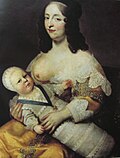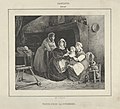Wet nurse: Difference between revisions
CSV import |
CSV import |
||
| Line 24: | Line 24: | ||
{{Child-stub}} | {{Child-stub}} | ||
{{History-stub}} | {{History-stub}} | ||
<gallery> | |||
File:Louis_XIV_as_an_infant_with_his_nurse_Longuet_de_la_Giraudiere.jpg|Louis XIV as an infant with his nurse Longuet de la Giraudiere | |||
File:Walcourt_-_Parclose_-_Satire_d'une_nourice.JPG|Satire d'une nourice | |||
File:A_Russian_wet_nurse,_c._1913.jpg|A Russian wet nurse, c. 1913 | |||
File:4796_-_Brescia_-_S._Giulia_-_Stele_di_Lucio_Nutrio_Gallo_(sec._I)_-_Foto_Giovanni_Dall'Orto,_25_Giu_2011.jpg|Stele di Lucio Nutrio Gallo | |||
File:Catherine_Willoughby_exiled.jpg|Catherine Willoughby exiled | |||
File:The_bureau_of_wet_nurses_in_Paris_-_wet_nurses_waiting_to_be_Wellcome_V0015043.jpg|The bureau of wet nurses in Paris - wet nurses waiting to be | |||
File:Wet_Nurse.png|Wet Nurse | |||
File:Visite_Chez_la_Nourrice_(Visit_to_the_Wetnurse)_(from_Journal_l'Artiste)_MET_DP841080.jpg|Visite Chez la Nourrice (Visit to the Wetnurse) | |||
File:An_infant_who_has_been_living_with_a_wet-nurse_being_taken_a_Wellcome_V0015113.jpg|An infant who has been living with a wet-nurse being taken away | |||
</gallery> | |||
Latest revision as of 11:45, 18 February 2025
Wet nurse is a woman who breastfeeds and cares for another's child. Wet nurses are employed if the mother dies, or if she is unable or chooses not to nurse the child herself. Wet-nursed children may be known as "milk-siblings", and in some cultures, the families are linked by a special relationship of milk kinship.
History[edit]
The practice of wet nursing is ancient and widespread. It has been noted in many cultures, including Europe, Asia, and the Americas. In early European history, wet nursing was a well-paid, respectable and popular job for many lower-class women. In the 18th century, however, the role of the wet nurse changed dramatically as the Enlightenment and the Industrial Revolution altered societal views on motherhood and the importance of biological ties.
Cultural Aspects[edit]
In many cultures, especially in the West, wet nurses were only used by the aristocracy, or when the mother was unable to feed her child for health reasons. In these cultures, the hiring of a wet nurse was seen as a status symbol. In other cultures, however, such as in Africa and Asia, wet nursing is a communal duty, and the child is often breastfed by multiple women in the community.
Health and Psychological Aspects[edit]
The health and psychological implications of wet nursing can be significant. For the wet nurse, there is the potential for infections to be passed between her and the child. For the child, there may be psychological effects from being cared for by someone other than their biological mother. However, in many cases, the benefits of breastfeeding, such as improved immunity and nutrition, outweigh these potential risks.
Modern Day Wet Nursing[edit]
In the modern day, the practice of wet nursing has declined in many parts of the world, particularly in the West. However, it still remains a common practice in many parts of Africa and Asia. In recent years, there has been a resurgence of interest in wet nursing in the West, particularly among women who are unable to breastfeed due to medical reasons.
See Also[edit]
This child development related article is a stub. You can help WikiMD by expanding it.
-
Louis XIV as an infant with his nurse Longuet de la Giraudiere
-
Satire d'une nourice
-
A Russian wet nurse, c. 1913
-
Stele di Lucio Nutrio Gallo
-
Catherine Willoughby exiled
-
The bureau of wet nurses in Paris - wet nurses waiting to be
-
Wet Nurse
-
Visite Chez la Nourrice (Visit to the Wetnurse)
-
An infant who has been living with a wet-nurse being taken away









